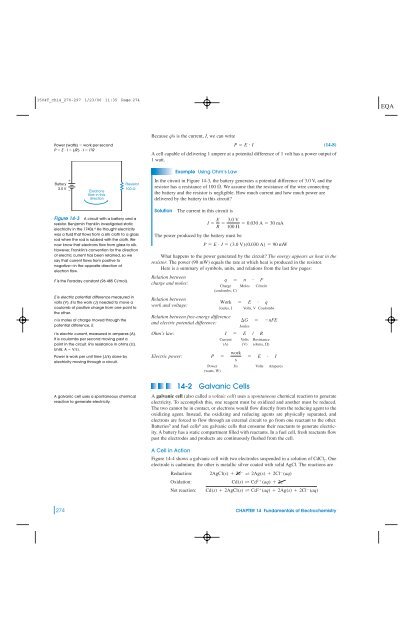Fundamentals of Electrochemistry - W.H. Freeman
Fundamentals of Electrochemistry - W.H. Freeman
Fundamentals of Electrochemistry - W.H. Freeman
Create successful ePaper yourself
Turn your PDF publications into a flip-book with our unique Google optimized e-Paper software.
1504T_ch14_270-297 1/23/06 11:35 Page 274<br />
Power (watts) work per second<br />
P E I (IR ) I I 2 R<br />
Because q/s is the current, I, we can write<br />
P E I<br />
(14-8)<br />
A cell capable <strong>of</strong> delivering 1 ampere at a potential difference <strong>of</strong> 1 volt has a power output <strong>of</strong><br />
1 watt.<br />
Example Using Ohm’s Law<br />
+<br />
Battery<br />
3.0 V<br />
–<br />
Electrons<br />
flow in this<br />
direction<br />
Resistor<br />
100 Ω<br />
In the circuit in Figure 14-3, the battery generates a potential difference <strong>of</strong> 3.0 V, and the<br />
resistor has a resistance <strong>of</strong> 100 . We assume that the resistance <strong>of</strong> the wire connecting<br />
the battery and the resistor is negligible. How much current and how much power are<br />
delivered by the battery in this circuit?<br />
Figure 14-3 A circuit with a battery and a<br />
resistor. Benjamin Franklin investigated static<br />
electricity in the 1740s. 4 He thought electricity<br />
was a fluid that flows from a silk cloth to a glass<br />
rod when the rod is rubbed with the cloth. We<br />
now know that electrons flow from glass to silk.<br />
However, Franklin’s convention for the direction<br />
<strong>of</strong> electric current has been retained, so we<br />
say that current flows from positive to<br />
negative—in the opposite direction <strong>of</strong><br />
electron flow.<br />
F is the Faraday constant (96 485 C/mol).<br />
E is electric potential difference measured in<br />
volts (V). E is the work (J) needed to move a<br />
coulomb <strong>of</strong> positive charge from one point to<br />
the other.<br />
n is moles <strong>of</strong> charge moved through the<br />
potential difference, E.<br />
I is electric current, measured in amperes (A).<br />
It is coulombs per second moving past a<br />
point in the circuit. R is resistance in ohms ().<br />
Units: A V/.<br />
Power is work per unit time (J/s) done by<br />
electricity moving through a circuit.<br />
Solution<br />
The current in this circuit is<br />
The power produced by the battery must be<br />
What happens to the power generated by the circuit? The energy appears as heat in the<br />
resistor. The power (90 mW) equals the rate at which heat is produced in the resistor.<br />
Here is a summary <strong>of</strong> symbols, units, and relations from the last few pages:<br />
Relation between<br />
charge and moles:<br />
Relation between<br />
work and voltage:<br />
Relation between free-energy difference<br />
and electric potential difference:<br />
Ohm’s law:<br />
Electric power:<br />
I E R 3.0 V 0.030 A 30 mA<br />
100 <br />
P E I (3.0 V)(0.030 A) 90 mW<br />
q n F<br />
Charge Moles C/mole<br />
(coulombs, C)<br />
Work E q<br />
Joules, J Volts, V Coulombs<br />
G nFE<br />
Joules<br />
I E / R<br />
Current Volts Resistance<br />
(A) (V) (ohms, )<br />
P work<br />
s<br />
E I<br />
Power J/s Volts Amperes<br />
(watts, W)<br />
A galvanic cell uses a spontaneous chemical<br />
reaction to generate electricity.<br />
14-2 Galvanic Cells<br />
A galvanic cell (also called a voltaic cell) uses a spontaneous chemical reaction to generate<br />
electricity. To accomplish this, one reagent must be oxidized and another must be reduced.<br />
The two cannot be in contact, or electrons would flow directly from the reducing agent to the<br />
oxidizing agent. Instead, the oxidizing and reducing agents are physically separated, and<br />
electrons are forced to flow through an external circuit to go from one reactant to the other.<br />
Batteries 5 and fuel cells 6 are galvanic cells that consume their reactants to generate electricity.<br />
A battery has a static compartment filled with reactants. In a fuel cell, fresh reactants flow<br />
past the electrodes and products are continuously flushed from the cell.<br />
A Cell in Action<br />
Figure 14-4 shows a galvanic cell with two electrodes suspended in a solution <strong>of</strong> CdCl 2 . One<br />
electrode is cadmium; the other is metallic silver coated with solid AgCl. The reactions are<br />
Reduction: 2AgCl(s) 2e T 2Ag(s) 2Cl (aq)<br />
Oxidation:<br />
Cd(s) T Cd 2 (aq) 2e <br />
Net reaction: Cd(s) 2AgCl(s) T Cd 2 (aq) 2Ag(s) 2Cl (aq)<br />
274 CHAPTER 14 <strong>Fundamentals</strong> <strong>of</strong> <strong>Electrochemistry</strong>

















